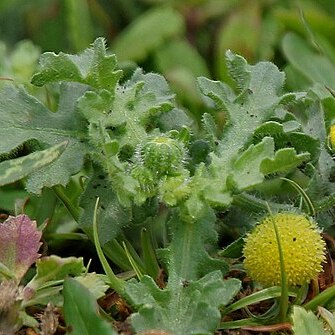Annual (or ?sometimes perennial) herb, with taproot, procumbent or with erect stems to 30 cm high, loosely branched, aromatic; stems striate or grooved, pubescent with white hairs and sparsely glandular.. Leaves pale green, sessile, in outline obovate to oblanceolate, 1–9.5(–15) cm long, 0.3–4 cm wide, the base half-amplexicaul, the margins lyrate-pinnatifid with serrate-crenate lobes or less often just lobed, the apex obtuse, pubescent to pilose on both surfaces and glandular.. Capitula solitary and axillary or leaf-opposed, or terminal with 2–3 together in leafy corymbs, individual heads subglobose, 4–12 mm long, 6–14 mm in diameter, erect in flower, nodding in fruit; peduncle to 2.5 cm long, pilose; phyllaries ± 17, 2–3-seriate, ovate to elliptic, the outermost 4–7 mm long, 1.5–2.5 mm wide, the inner slightly smaller, acute to obtuse, pubescent, fimbriate, the inner with scarious margins; receptacle conical.. Outer florets pale to golden yellow, female, shortly (0.5–1 mm) stalked, in ± 3 rows, many, narrowly tubular with the tube 1.3–1.5 mm long, sparsely glandular, widening near the mouth, with 2–4 teeth 0.2–0.3 mm long, style ± 2.5 mm long; inner florets pale to golden yellow, many, shortly (0.5–1 mm) stalked, sparsely glandular, tube 1–1.2 mm long and widening towards the mouth with 4–5 triangular lobes 0.3–0.5 mm long; anthers 0.5–0.6 mm long with triangular appendages, style 1.5–2.3 mm long.. Achenes yellow, narrowly obovoid, slightly compressed, with 2(–4) marginal veins, 1.2–2 mm long, sparsely hairy and glandular; pappus a massive coroniform ring, laciniate, 0.3–0.5 (?–1.3) mm long.. Fig. 97.
Herbs, annual, (5-)10-30 cm tall. Stems slender, usually procumbent, branched, white villous or glabrescent in lower part by anthesis. Leaves usually obovate, oblanceolate, or obspatulate, 3.5-7.5 × 1.5-2.5 cm, surfaces white villous, glandular; basal sessile, blade pandurate or lyrate-lobate, to ca. 10 × 4 cm, base usually auriculate, terminal lobe obovate or suborbicular, margin coarsely dentate, lateral lobes 2-5-paired; upper gradually smaller. Capitula terminal, solitary, rarely paired, 8-10 mm in diam. Involucre hemispheric; phyllaries 2-or 3-seriate, outer series lanceolate-ovate, 4-8 mm, outer surface villous, margin fimbriate, ciliate, apex acute to obtuse, inner series oblanceolate or obovate, clawed, obtuse. Receptacles hemispheric. Florets sparsely glandular; marginal female florets yellow, 2-6-seriate, corolla filiform, ca. 1 mm, shortly 2-or 4-lobed; disk florets shortly cylindric campanulate, ca. 1.5 mm, lobes ovate. Achenes compressed, glabrous, glandular, ± thickly 2-ribbed, apex truncate, with a thickened, toothed ring. Pappus absent. Fl. and fr. Jan-Aug.
A leafy herb. It grows each year from seed. It lies along the ground. It forms round patches. It grows 50 cm tall. The stems are hairy. The leaves have stalks. The edges are deeply wavy and divided into narrow leaflets. The flower heads are green or yellow. The fruit is an achene.
A hairy annual or perennial herb or shrub with prostrate branches from a woody root, odorous
Florets yellow


